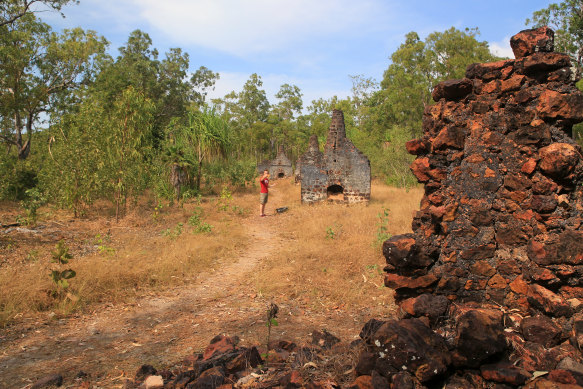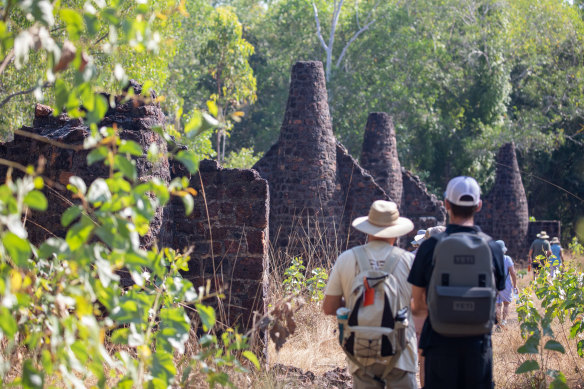The bizarre Australian ghost town that was supposed to repel an invasion
By Sue Williams
Squint against the blistering sunlight, and you can almost see ghosts flitting between the remnants of walls, fireplaces, chimneys and foundation stones of one of the most bizarre towns the world has ever seen.

The remains of the remote hospital at Victoria Settlement.Credit: Tourism NT/Chris Frankenfeld
As far away as you can possibly get from any other white human settlement, and in the most hostile environment imaginable, a contingent of mariners, soldiers, their wives and children, convicts, and a surgeon set up home in 1838 on the remote Cobourg Peninsula in Arnhem Land, about 570 kilometres (by road) north-east of Darwin.
There, dressed in layers of thick woollen clothes in suffocating tropical temperatures, they toiled through famine, disease and a devastating cyclone to form a township to defend Australia from possible incursions by the Dutch and to supply passing ships.
The local Indigenous people watched on in shock, and often horror, as the newcomers battled the elements and often stole artefacts and human remains to, one day, send back to Britain.
Today, looking out at the ruins that remain of the Victoria Settlement in the middle of absolutely nowhere, it seems a ludicrous experiment. But the brave souls who attempted it gave it everything they had – often their lives, too.

Only the chimneys remain of the officers’ houses.Credit: Tourism NT/Chris Frankenfeld
“One of the difficulties was that when Captain Phillip Parker King explored this area and said it had lots of fresh water, he’d been here at the end of the wet season,” says guide Olivia Sloan, who’s taken us by boat to this isolated spot at Port Essington after a 13-day Outback Spirit tour of Arnhem Land.
“But when everyone actually arrived, it was the middle of the dry season. There was so little water, everyone had to dig wells in the hope of finding enough. Conditions were so harsh, it wasn’t long before everyone started getting sick.”
Many of the buildings were prefabricated back in England so, at the optimistic start, it looked something like a pretty English village with green grass between the thatched roof cottages. But from what remains, it’s easy to see how unsuited everything was for the climate, and to understand how quickly the settlers’ dreams, along with the buildings, crumbled.
The ruins of each house still sport chimneys for the fireplaces inside, and thick walls to retain the heat – a nightmare in a Northern Territory summer. The hospital, whose foundations stand on the hillside looking out to sea, had no windows to capture the breeze. At times, over half the garrison was crammed into the four tiny rooms, sick with scurvy, malaria, diarrhoea, dysentery and the flu.

After 11 years, the British government sent word that the settlement was to be abandoned.
A cyclone hit the following year, and it was so strong, it lifted the settlement’s Government House clean off its piers and dropped it three metres away, and completely swept away the 43-metre-long jetty. Ten people were later found to have died in the storms.
In addition, nearly everyone suffered, at one point or another, from a mysterious “fever” which ended up killing about a quarter of the settlers.
While at first they wrongly suspected it might be Indigenous people angry at the way they were being treated, poisoning the water in their wells, it turned out to be something far more deadly: malaria.
“The plan for the settlement was ill-conceived, the site ill-chosen and the Royal Marines unsuited to the task of establishing themselves in an isolated and harsh environment,” writes Peter Spillett, an expert in Northern Territory history, in his book, Forsaken Settlement.
Nowadays, it’s a fascinating look at how white settlers in colonial Australia often battled the elements in a state of absolute ignorance about local conditions. They strove to replicate their lives in England, even setting up a kiln to produce bricks to build typical English houses with little regard for the local climate.
The most successful part of the whole town, tragically, was the cemetery, with the headstones telling the sad stories of the deaths of each one of the children either brought to the settlement or who were born there, as well as a huge number of the men and women, 58 in total.
Happily, after 11 years, the British government sent word that the settlement was to be abandoned, and the residents could all come home. As you wander around the godforsaken site that feels very much like the end of the world, you can only imagine the relief.
THE DETAILS
TOUR
Outback Spirit’s 13-day tour of Arnhem Land, ending with three nights at Cobourg Peninsula and visiting Victoria Settlement, take place May to October. From $14,495 a person twin-share. See outbackspirittours.com.au
FLY
Qantas flies from Cairns to Nhulunbuy daily. See qantas.com.au
Outback Spirit has its own aircraft that fly between the Cobourg Peninsula and Darwin.
The writer was a guest of Outback Spirit.
Sign up for the Traveller Deals newsletter
Get exclusive travel deals delivered straight to your inbox. Sign up now.